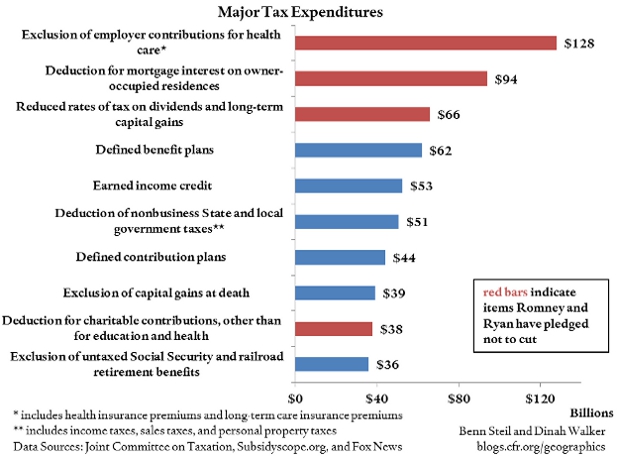There’s a $1 Trillion Hole in Romney’s Budget Math
October 18, 2012 1:05 pm (EST)
- Post
- Blog posts represent the views of CFR fellows and staff and not those of CFR, which takes no institutional positions.
More on:

In last week’s vice-presidential debate, Republican Paul Ryan defended the fiscal prudence of lowering top marginal income tax rates by arguing that it would be accompanied by “forego[ing] about $1.1 trillion in loopholes and deductions . . . deny[ing] those loopholes and deductions to higher-income taxpayers.” The $1.1 trillion he refers to is actually an amalgam of specific “tax expenditures” – benefits distributed through reductions in taxes otherwise owed – identified by the Joint Committee on Taxation. We break out the largest 10 of these graphically in the figure above. The full list is available here: http://subsidyscope.org/data/
The red bars indicate items that Romney and Ryan had previously promised not to touch: exclusion of employer contributions for health care, deductions for mortgage interest, reduced tax rates on dividends and long-term capital gains, and deductions for charitable giving. These four items constitute a massive 30% of the $1.1 trillion. Therefore the Ryan pledge to cut loopholes and deductions cannot, mathematically, be worth more than $770 billion.
And note some of the other big-ticket “loopholes and deductions” on the list. Social security and other retirement income constitute three of the top ten items, together making up 13% of the total, and the earned income credit, which benefits the poor, represents another 5% of the total. Would Romney and Ryan eliminate those deductions? We’ll speculate here: no. A quick skim of the remainder shows that few of these items constitute “loopholes” in the public’s mind – they are items few imagine could or should be taxed.
In short, Romney and Ryan cannot, logically, keep the pledge to cut $1.1 trillion in tax shields for the rich, because (1) they have already ruled out eliminating the biggest of such shields, and (2) much of the $1.1 trillion is actually derived from tax expenditures targeted at lower and middle income taxpayers – not tax shields for the rich. This almost surely means that only a small fraction of the $1.1 trillion is actually in play.
Sensitive to the charge that his numbers are not adding up, Romney proposed at Tuesday night’s presidential debate capping deductions at $25,000. This would raise $1.3 trillion in revenues over the next ten years, according to the Tax Policy Center. But that figure is only slightly above what Ryan said they would raise each year. A $1 trillion a year hole remains in their budget math.
Transcript: The 2012 Vice Presidential Debate
Pew: Subsidyscope Tax Expenditure Database
Ryan: Sept. 30 Appearance on Fox News Sunday
More on:
 Online Store
Online Store